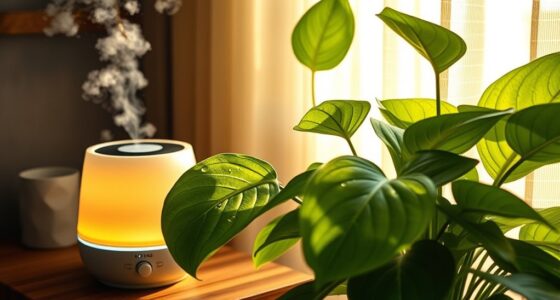To care for your indoor flowering plants, ensure they get 6-8 hours of bright, indirect light daily. Water them precisely at the root zone, allowing excess to drain. Maintain a temperature of 65°F to 75°F while keeping humidity between 40-60%. Fertilize monthly during spring and summer with a phosphorus-rich formula. Don’t forget to prune regularly and check for pests. Keep an eye on their stress signs to keep them thriving. There’s so much more to explore!
Key Takeaways
- Ensure flowering plants receive at least 6-8 hours of bright, indirect light daily to promote healthy growth.
- Water consistently and check soil moisture regularly to prevent root rot and maintain optimal hydration.
- Maintain indoor temperatures between 65°F and 75°F and humidity levels of 40% to 60% for ideal conditions.
- Fertilize with a phosphorus-rich product monthly during the growing season and avoid during dormancy.
- Regularly prune dead or damaged leaves and monitor for pests to support plant health and vigor.
Lighting Requirements for Indoor Flowering Plants

When caring for indoor flowering plants, understanding their lighting requirements is crucial, as the right amount and type of light can significantly impact their growth and blooming.
Understanding the lighting needs of indoor flowering plants is essential for promoting healthy growth and vibrant blooms.
Many flowering plants thrive in high light, often needing over 500 footcandles, which you can achieve near south-facing windows. Using a light meter can help you measure the intensity your plants receive. Proper light management is essential to ensure that your plants receive the right amount of exposure without risking damage from excessive light. Additionally, consider the growing seasons when determining the light needs of your plants, as they may vary throughout the year. Incorporating energy-efficient LED fixtures can also provide the necessary light spectrum for optimal plant growth without wasting energy. Certain plants, like orchids, require specific light conditions that can be replicated with proper lighting setups.
Aim for at least 6-8 hours of bright, indirect light daily, adjusting this based on seasonal changes. Remember that while high light promotes healthy blooms, too much can damage leaves.
If natural light is lacking, consider supplemental artificial lighting, especially with LED lights that provide the specific wavelengths your plants need for optimal growth.
Watering Techniques for Optimal Growth

How can you ensure your indoor flowering plants thrive through proper watering techniques?
Start by using a narrow spout watering can for precise watering at the root zone, avoiding wet flowers that can lead to fungal diseases. Consider self-watering planters to maintain consistent moisture levels. To check soil moisture, use the finger dip technique or a moisture meter. Always allow excess water to drain to prevent root rot, and adjust your watering frequency based on seasonal changes. When watering, use room temperature water and ensure your pots have drainage holes. For plants sensitive to leaf moisture, like African violets, try bottom watering. Lastly, avoid softened water and consider using rainwater or filtered water for the best results. Proper drainage is essential to reduce fungal growth and support healthy root development. Additionally, remember that soil moisture check is vital to determine when your plants need water, ensuring they receive the appropriate amount without overwatering. Regularly checking the air quality in your home can also enhance the overall health of your plants, as clean air can improve their growth conditions. Incorporating sustainable practices in your plant care, such as using eco-friendly fertilizers, can further promote healthy growth.
Temperature and Humidity Management

To ensure your indoor flowering plants flourish, managing temperature and humidity is crucial. Most flowering plants thrive between 65°F and 75°F during the day, with a beneficial nighttime drop of about 10°F. Keep them away from drafts to maintain stable temperatures, and adjust for seasonal changes. For humidity, aim for levels between 40% and 60%. You can increase humidity by placing plants on trays filled with pebbles and water or using a room humidifier. Proper priming for plants, similar to paint, can enhance their growth by ensuring they receive adequate moisture. Additionally, providing regular cleaning of their environment can help prevent pests and diseases. Grouping plants together also helps create a more humid environment. Additionally, be mindful of temperature preferences as different flowering plants may have specific needs that can affect their growth. To support their development further, consider implementing consistent routines similar to those used in co-parenting, as this can provide stability for your plants.
Fertilization Strategies for Healthy Blooms

Understanding the right fertilization strategies is essential for promoting healthy blooms in your indoor flowering plants.
Choose a fertilizer with a higher phosphorus content, like a 10-30-20 ratio, to encourage flowering and root development. During active growth periods in spring and summer, fertilize monthly, but avoid winter applications when plants are dormant. Soil-based plants require fertilization for optimal appearance and growth, as they extract nutrients from the soil over time. Implementing vertical storage solutions can help you keep your plant care materials organized and easily accessible. Additionally, incorporating non-toxic materials in your plant care routine can enhance safety and effectiveness. Regularly fertilizing your plants can also help support overall wellness, similar to how juice cleanses boost health.
Select a phosphorus-rich fertilizer, such as a 10-30-20 ratio, and fertilize monthly during spring and summer for optimal blooms.
You can use water-soluble fertilizers for consistent feeding or time-release options for less frequent care. Always dilute fertilizers to prevent overfertilization, which can lead to root damage and wilting.
Regularly monitor your plants’ health and adjust based on their needs. By following these strategies, you’ll support vibrant blooms and overall plant vitality.
Pruning and Maintenance Practices

Pruning and maintenance are crucial for keeping your indoor flowering plants healthy and thriving. Start by pruning at the beginning of the growing season—late winter or early spring—to encourage new growth. Use sharp, clean tools for effective cuts and remember to prune diseased or dying leaves to prevent disease spread. Pruning promotes healthy growth by removing dead or dying foliage. Additionally, color accuracy in your plant’s environment can enhance their overall appearance and health. Water when the soil surface is dry, and maintain humidity with misting or a pebble tray. Baked kale retains essential nutrients that can inspire you to incorporate healthy practices into your plant care routine. It’s also important to choose pots made from natural materials to ensure proper drainage and contribute to a healthy environment.
Keep your plants in a temperature range of 55-75°F and ensure they get appropriate lighting. Regularly inspect for pests and act quickly to prevent infestations. After pruning, continue consistent watering and adjust lighting to support recovery. Monitor for stress signs like yellowing leaves and clean up any debris promptly.
Frequently Asked Questions
How Do I Identify Pests on My Indoor Flowering Plants?
To identify pests on your indoor flowering plants, regularly inspect the leaves and stems for any unusual signs.
Look for tiny insects like aphids or mealybugs, and check for sticky honeydew or webbing from spider mites.
You might notice leaf damage, such as holes or yellowing.
Pay attention to any small black fecal spots, which can indicate thrips.
Keeping your plants clean and healthy will also help prevent infestations.
Can I Use Tap Water for Watering My Plants?
Did you know that about 85% of households use tap water for their plants?
You can use tap water to water your plants, but be mindful of the chemicals it contains. Chlorine, for instance, can harm plants over time, so let the water sit for 24 hours to dissipate it.
Avoid softened water with high sodium levels, and monitor your plants for any signs of stress to ensure they thrive.
What Should I Do if My Plant Is Wilting?
If your plant’s wilting, you need to diagnose the issue quickly.
Check for overwatering by feeling the soil; if it’s soggy, stop watering and trim any rotten roots before repotting in well-draining soil.
If the soil’s dry, give it a good soak.
Also, inspect for pests or inadequate light.
Adjust its environment if needed, and ensure it’s getting the right care to help it recover and thrive.
How Can I Propagate My Indoor Flowering Plants?
Perfectly propagate your indoor flowering plants by choosing the right method!
Start with water propagation for Pothos by placing cuttings in a glass of water. For African violets, use leaf cuttings planted in moist soil.
You can also divide clumping plants like Peace lilies into smaller sections.
Don’t forget to provide bright, indirect sunlight and consistent moisture to help your new plants thrive.
Soon, you’ll have a flourishing indoor garden!
Is It Safe to Keep Indoor Plants Around Pets?
It’s essential to consider plant safety when you have pets. Some indoor plants can be toxic to dogs and cats, causing health issues if ingested.
You should research each plant’s toxicity before bringing it home. Opt for pet-friendly varieties like spider plants or African violets.
Keeping plants out of reach and training your pets to avoid them can also help create a safe environment while enjoying the beauty of indoor greenery.
Conclusion
Just like a gardener tending to a vibrant tapestry of flowers, your care for indoor flowering plants weaves a story of growth and beauty. By nurturing their light, water, and warmth, you’re crafting a sanctuary where they can bloom and thrive. Remember, each plant is like a unique character in your garden’s tale, needing your attention to flourish. So, embrace your role as the storyteller, and watch as your indoor haven flourishes into a breathtaking masterpiece.










